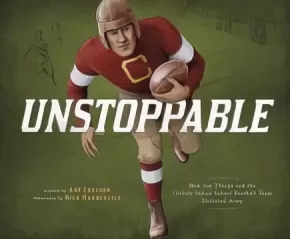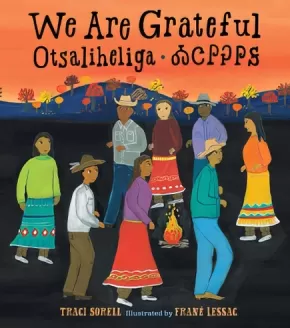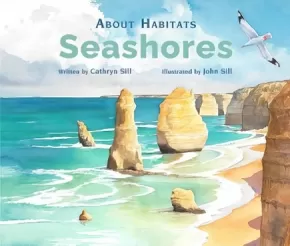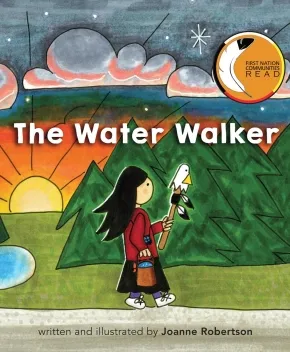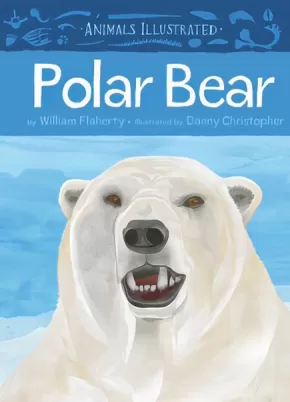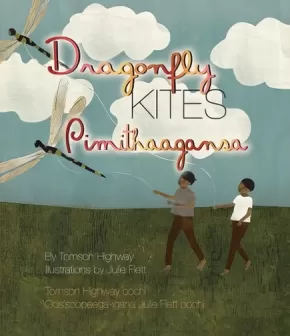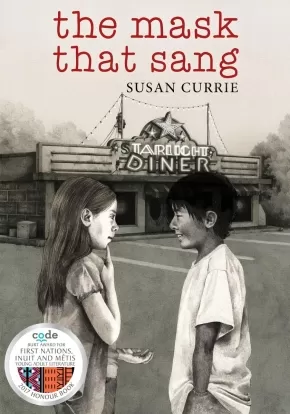
Award-Winning
76
-
90
of
104 Results;
Sort By
Go To
of 7
Spirit Bear: Fishing for Knowledge, Catching Dreams: Based on a True Story
$12.95
Artists:
Format:
Paperback
Text Content Territories:
Indigenous Canadian; First Nations;
ISBN / Barcode: 9781775191421
Synopsis:
Synopsis:
Spirit Bear is off on another adventure! Follow him as he learns about traditional knowledge and Residential Schools from his Uncle Huckleberry and his friend, Lak'insxw, before heading to Algonquin territory, where children teach him about Shannen's Dream.
Spirit Bear and his new friends won't stop until Shannen's Dream of "safe and comfy schools" comes true for every First Nations student.
Dear Uncle Huckleberry,
Look up at the stars tonight. If you look closely, you'll see Shannen Koostachin lighting the way.
Shannen knew that school should be a time for dreams and that every child deserves to have a safe and comfy school, a proper education, and to feel proud of who they are. Every child is sacred.
Did you know that many First Nations schools get less money from the government than other schools? Shannen knew this was wrong. And so do I.
And like my mom, Mary the Bear, always says, when we see something wrong, we need to help make things right!
Did you know that Lak'insxw means "grizzly bear" in Gitxsan language?
Educator & Series Information
Recommended for ages 6 to 12.
This book is part of the Spirit Bear series.
This resource is also available in French: Spirit Bear: pêcher le savoir, attraper des rêves : Base sur une histoire vraie
Additional Information
52 pages | 216 x 216 mm
Surviving the City Vol. 1
$21.95
Artists:
Format:
Paperback
Text Content Territories:
Indigenous Canadian; First Nations; Cree (Nehiyawak); Anishinaabeg;
ISBN / Barcode: 9781553797562
Synopsis:
Synopsis:
Tasha Spillett’s graphic novel debut, Surviving the City, is a story about womanhood, friendship, colonialism, and the anguish of a missing loved one.
Miikwan and Dez are best friends. Miikwan is Anishinaabe; Dez is Inninew. Together, the teens navigate the challenges of growing up in an urban landscape – they’re so close, they even completed their Berry Fast together. However, when Dez’s grandmother becomes too sick, Dez is told she can’t stay with her anymore. With the threat of a group home looming, Dez can’t bring herself to go home and disappears. Miikwan is devastated, and the wound of her missing mother resurfaces. Will Dez’s community find her before it’s too late? Will Miikwan be able to cope if they don’t?
Awards
- Winner of the 2019 Indigenous Voices Award for Works in an Alternative Format
- Co-winner of the Eileen McTavish Sykes Award for Best First Book by a Manitoba Author
- Winner of the Manuela Dias Design and Illustration Award, Graphic Novel category
Educator & Series Information
Recommended Grades: 7-12.
This graphic novel is part of the Surviving the City series, which is also part of the Debwe Series.
The Surviving the City series includes these titles:
- Surviving the City
- From the Roots Up
- We Are the Medicine
Recommended in the Canadian Indigenous Books for Schools 2019-2020 resource list for grades 10 to 12 for English Language Arts and Social Studies.
This book could be triggering for some readers as it contains mature content and focuses on issues such as Missing and Murdered Indigenous Women and Girls.
A Teacher Guide is available: Surviving the City Teacher Guide: Exploring Identity, Allyship, and Social Action for Meaningful Change in Grades 7-12
Additional Information
56 pages | 6.50" x 10.00"
Unstoppable: How Jim Thorpe and the Carlisle Indian School Football Team Defeated Army
$9.95
Artists:
Format:
Paperback
Text Content Territories:
Indigenous American; Native American; Meskwaki (Fox); Sac (Sauk);
ISBN / Barcode: 9781543504132
Synopsis:
Synopsis:
In the autumn of 1912, the football team from Carlisle Indian Industrial School took the field at the U.S. Military Academy, home to the bigger, stronger, and better-equipped West Points Cadets. Sportswriters billed the game as a sort of rematch, pitting against each other the descendants of U.S. soldiers and American Indians who fought on the battlefield only 20 years earlier. But for lightning-fast Jim Thorpe and the other Carlisle players, that day's game was about skill, strategy, and determination. Known for unusual formations and innovative plays, the Carlisle squad was out to prove just one thing -- that it was the best football team in all the land.
Awards
- 2018 American Indians in Children's Literature winner
- 2018 The Children's Book Podcast winner
- 2019 Virginia Library Association winner
Educator Information
Recommended Ages: 6-10
Additional Information
40 pages | 11.00" x 9.00"
We Are Grateful: Otsaliheliga
$21.99
Artists:
Format:
Hardcover
Text Content Territories:
Indigenous American; Native American; Cherokee; Cherokee Nation (Cherokee Nation of Oklahoma);
ISBN / Barcode: 9781580897723
Synopsis:
Synopsis:
The Cherokee community is grateful for blessings and challenges that each season brings. This is modern Native American life as told by an enrolled citizen of the Cherokee Nation.
The word otsaliheliga (oh-jah-LEE-hay-lee-gah) is used by members of the Cherokee Nation to express gratitude. Beginning in the fall with the new year and ending in summer, follow a full Cherokee year of celebrations and experiences. Written by a citizen of the Cherokee Nation, this look at one group of Native Americans is appended with a glossary and the complete Cherokee syllabary, originally created by Sequoyah.
Awards
- 2019 Sibert Honor Book
- NPR's Guide to 2018's Great Reads
- Kirkus Reviews Best Books of 2018
- 2018 Book Launch Award (SCBWI)
Reviews
"According to storyteller Sorell, the Cherokee people always express gratitude for the little things they are given by saying the phrase, "Otsaliheliga," or "we are grateful." Raised in the Cherokee Nation, Sorell intentionally crafts a narrative that simultaneously embraces modernity and a traditional presentation of Cherokee community and way of life. Throughout, the measured text reminds readers that in all things "we say otsaliheliga." Colorful, folk art-style illustrations show Cherokee people during ceremonies, in family gatherings large and small, and outdoors enjoying each of the four seasons, always expressing gratitude. The scenes are contemporary; one shows a father taking care of his children, engaging in a positive parenting role, while another depicts a family seeing off a relative who is leaving for deployment in the military, underscoring that Cherokee people serve their country. Children participate in rites and in family outings with adults, and they also play traditional games such as stickball and plant strawberries, a practice that reminds their people to embrace peace with one another. The variety of skin tones represented in the illustrations likewise depicts a present-day reflection of the diversity that exists within the Cherokee people. Occasional Cherokee words are written in Romanized form, phonetically, in Cherokee characters, and in English—a lovely grace note. A gracious, warm, and loving celebration of community and gratitude. —Kirkus Reviews
"An extended family engages with activities and traditions that express gratitude and carry on Cherokee history and culture, such as stomp dancing at the Great New Moon Ceremony, basket weaving, making corn-husk dolls, and playing stickball. The book underscores the importance of traditions and carrying on a Cherokee way of life while simultaneously incorporating modernity and challenging dated media images of Indigenous people. Here, a father sporting an earring and a topknot minds the children; a family bids goodbye to a clan relative who deploys with the U.S. military. Skin colors range from light to dark, visually underscoring the book’s message of diversity and inclusion. Staying firmly upbeat and idyllic, the cheerful, richly detailed gouache illustrations in bright, saturated colors cycle through the seasons, beginning with the Cherokee New Year in autumn. The text includes several Cherokee words; a line of text in a smaller font along the bottom of the page provides each word as written in the English alphabet, its phonetic pronunciation, the word as written in the Cherokee alphabet, and its definition. A glossary, an author’s note on Cherokee culture, and a complete Cherokee syllabary conclude this attractive and informative book." —Horn Book
"In Cherokee culture, Sorell shares, the expression of gratitude is part of daily life and extends from elaborate celebrations to struggles to ordinary life moments. She organizes her debut picture book by seasons, beginning with the fall, which is a time for collecting foliage for basket making and remembering those who suffered on the Trail of Tears. It also contains the Cherokee New Year and the Great New Moon Ceremony, a celebration of renewal and coming together. Each season section starts with the name of the season in Cherokee, an expression of gratitude for the change in nature, and subsequent pages describing community activities pertinent to that season. Lessac's folkloric illustration in bright gouache colors stands in pleasing contrast to the book’s contemporary feel and setting. The text reads like poetry but has a gentle instructional dimension to it. On many pages, Cherokee words are accompanied by English translations, pronunciation guides, and Cherokee syllabary. Back matter contains relevant explanations and provides good context, and the author's note sets past misrepresentations right" —Booklist
"This informative and authentic introduction to a thriving ancestral and ceremonial way of life is perfect for holiday and family sharing"—School Library Journal
Educator Information
Recommended for ages 3 to 7.
Also available in a boxed set as board books for ages 3 and under: We Are Grateful Otsaliheliga: Seasons (BB - Box Set)
Additional Information
| 32 pages | 9.88" x 10.00" |
A Day With Yayah
$21.95
Artists:
Format:
Hardcover
Text Content Territories:
Indigenous Canadian; First Nations; Salish; Interior Salish; Nlaka'pamux (Thompson);
ISBN / Barcode: 9781926890098
Synopsis:
Synopsis:
Set in the Okanagon, BC, a First Nations family goes on an outing to forage for herbs and mushrooms. Grandmother passes down her knowledge of plant life to her young grandchildren.
Reviews
"A Day With Yayah is a story sharing the special relationship that is built when a child learns from their Elders. It centers around an Indigenous family out on the land picking herbs and the Grandmother passing down her knowledge." - The Dalai Lama Center
Educator Information
Recommended for grades K-2 for the following subjects: Art Education, English Language Arts, Social Studies.
This resource offers a glimpse into the Nłeʔkepmx of the Nicola Valley in BC's Interior. A glossary of Nłeʔkepmxcin words appears at the back of the book.
Additional Information
32 pages | 9.25" x 10.25" | colour illustrations
About Habitats: Seashores
$11.99
Artists:
Format:
Paperback
ISBN / Barcode: 9781682634028
Synopsis:
Synopsis:
Studying nature? Going to the beach? Dig into this classroom favorite and beginner's guide to seashores from the creators of the award-winning About Habitats series.
In this accessible introduction to a familiar locale, author and educator Cathryn Sill uses simple, easy-to-understand language to teach children about seashores and their diversity, the types of animals and plants that live there, and why they're important.
The stunning paintings by noted wildlife illustrator John Sill depict the wide variety of seashore topography.
A glossary and afterword provide more details about each seashore featured in the book. Perfect for early childhood and elementary units on nature, environment, and ecosystems.
Awards
- Outstanding Science Trade Books for Students K-12 —National Science Teachers Association, Children’s Book Council, 2018 (US)
Reviews
“Another excellent edition… The beautifully designed layout and succinct text combine with the back matter to offer very accessible nonfiction reading for the very young as well as early grade students.” —Kirkus Reviews
“With reliable information and attractive illustrations, this volume is a useful addition to a series celebrating its tenth year.” —Booklist
“Useful for introductory units on marine and earth science.” —School Library Journal
Educator & Series Information
With simple text and language, and strong picture support (paintings), this non-fiction narrative teaches children what seashores are and what kinds of animals and plants live there.
Recommended ages: 3-7
This book is a part of the About Habitats series, which introduces children to specific habitats and their living and nonliving components.
Additional Information
48 pages | 10.00" x 8.50" | Paperback
Stolen Words
$21.95
Artists:
Format:
Hardcover
Text Content Territories:
Indigenous Canadian; First Nations; Cree (Nehiyawak);
ISBN / Barcode: 9781772600377
Synopsis:
Synopsis:
A little girl helps her grandfather regain the language taken from him as a child.
The story of the beautiful relationship between a little girl and her grandfather. When she asks her grandfather how to say something in his language – Cree – he admits that his language was stolen from him when he was a boy. The little girl then sets out to help her grandfather find his language again. This sensitive and warmly illustrated picture book explores the intergenerational impact of the residential school system that separated young Indigenous children from their families. The story recognizes the pain of those whose culture and language were taken from them, how that pain is passed down, and how healing can also be shared.
Awards
- 2018 Ruth and Sylvia Schwartz Children's Book Winner
Reviews
"Florence's tender text soothes the harsh reality of having Native language stolen while attending one of Canada's former residential schools for Indigenous children. Grimard's equally emotive illustrations show the stark realities of the experience in symbolic images... Unforgettable. (Starred Review)" — Kirkus Reviews
"... a sobering ode to [Florence's] heritage, presented through eyes filled with love and hope... Word by word, her story—written in honor of her Cree grandfather—is a significant step toward forever healing. (Starred Review)" — Shelf Awareness
"...an emotionally charged series of interactions and memories that are pure Melanie Florence. They will astound readers and sadden them, while encouraging healing and learning without shame or anger." — CanLit for Little Canadians
"Stolen Words would be an asset to any home or school library. It is a very powerful tool to educate both Indigenous and non-indigenous readers about the long lasting effects of the residential school system." — Anishinabek News
"An emotional read, as the illustrations show mothers waving goodbye to their children and words being lost. As Grandfather revisits his native first language, the words fly back.... Recommended." — School Library Journal
"This sensitive, beautifully illustrated picture book deftly explores the inter-generational impact of Canada's residential school system... Stolen Words is unreservedly and emphatically recommended for family, preschool, elementary school, and community library picture book collections." — Midwest Book Review
Educator Information
Recommended for ages 6 to 9.
This resource is also available in French: Les mots voles
This resource is also available in English and Plains Cree as kimotinâniwiw itwêwina / Stolen Words
Stolen Words was the winning manuscript from Second Story Press' 2015 Aboriginal Writing Contest. Melanie Florence has been recognized for her ability to write about Indigenous history and culture with sensitivity and compassion, and Quebec artist Gabrielle Grimard's illustrations perfectly capture the spirit of the story.
Additional Information
24 pages | 8.50" x 8.50"
The Marrow Thieves
$19.95
Format:
Paperback
Text Content Territories:
Indigenous Canadian; Métis;
ISBN / Barcode: 9781770864863
Synopsis:
Synopsis:
Humanity has nearly destroyed its world through global warming, but now an even greater evil lurks. The indigenous people of North America are being hunted and harvested for their bone marrow, which carries the key to recovering something the rest of the population has lost: the ability to dream. In this dark world, Frenchie and his companions struggle to survive as they make their way up north to the old lands. For now, survival means staying hidden - but what they don't know is that one of them holds the secret to defeating the marrow thieves.
Awards
- Winner of 2017 Governor General's Literary Award
- Winner of 2017 Kirkus Prize
- Winner of the 2018 Burt Literary Award for First Nations, Inuit, and Métis Young Adult Literature.
Reviews
“Miigwans is a true hero; in him Dimaline creates a character of tremendous emotional depth and tenderness, connecting readers with the complexity and compassion of Indigenous people. A dystopian world that is all too real and that has much to say about our own.”— Kirkus Reviews
"There's a quality in Dimaline's writing that reached from the page, into my being ... That's a specific reference to the residential schools of the past, where so much was taken from Native children. It is one of many points in The Marrow Thieves where - painfully or with exquisite beauty - Dimaline's story resonates with me. It will resonate with other Native readers, too, especially those who are Anishinabe. Several tribal nations are mentioned in here, too ... There's so much more to say ... about Miggs and Isaac, about Ri, about Minerva, about French. But I'll stop and let you be with these achingly dear characters. I highly recommend The Marrow Thieves." — Debbie Reese, American Indians in Children's Literature
"In The Marrow Thieves, Cherie Dimaline creates a near-future world which distinctly echoes our own, current and past traumas that have come back to repeat themselves, fiction with a basis in reality that gives the narrative a sheen of hard truths, following the trials and tribulations of a relatable cast of characters and their struggles to survive, and live their lives with the love and safety denied to them. The high-stakes tension of each scene pulls the reader along through the story, with a core message about our dreams and culture, which despite losses, has the potential to heal, and the power to restore." — Trillium Book Award Jury Citation, June 2018
"[The Marrow Thieves] brilliantly connects the legacy of residential schools to a dystopian post-climate-change future where only Indigenous people are able to dream. Dimaline’s novel reminds us of the power of storytelling and the importance of community, reinforced for the disenfranchised children by the wisdom of the heroic elder, Miigwans. The writing is painful yet beautiful, bleak but ultimately hopeful. In this era of reconciliation, Cherie Dimaline’s The Marrow Thieves is a work of speculative fiction that resonates and stays with the reader long past the last page." — Sunburst Award Jury Citation, October 2018
Educator & Series Information
Recommended Ages: 13+
Recommended English First Peoples resource for grades 11-12.
This book is part of the Marrow Thieves series.
The Canadian Indigenous Books for Schools list recommends this resource for Grades 9-12 English Language Arts.
Caution: This book touches on physical and sexual violence.
DCB Young Readers has created a Teacher's Guide for this resource, which can be downloaded here: Teachers Guide - The Marrow Thieves
This resource is also available in French: Pilleurs de rêves
Additional Information
180 pages | 5.00" x 8.00"
The Sockeye Mother
$23.00
Artists:
Format:
Hardcover
Text Content Territories:
Indigenous Canadian; First Nations; Gitxsan (Gitksan);
ISBN / Barcode: 9781553797395
Synopsis:
Synopsis:
To the Gitxsan people of Northwestern British Columbia, the sockeye salmon is more than just a source of food. Over its life cycle, it nourishes the very land and forests that the Skeena River runs through and where the Gitxsan make their home. The Sockeye Mother explores how the animals, water, soil, and seasons are all intertwined.
1 SMALL FRY
There’s a strong undertow today. The turbulent waters caress the backs of the little semelparous life forms emerging from their gravel nests. A small free-swimming fry bears witness to the currents of spring, after spending weeks developing and using up its nutritious yolk sack. It’s one of few remaining fry leaving its long winter’s home to seek out nursing waters.
This is the time of Wihlaxs (the black bear’s walking moon), which is early spring to the Gitxsan peoples of the Pacific Northwest Interior. Change is in the air, the days grow longer, and renewal is the life force that guides the world around the little fry’s waterways. Flora cells are starting to stir, preparing to bud and bring green to the landscape. Stores of food for the people along Xsan (river of mists) is running low, but preparations for the new seasons of fishing and gathering have begun. New snow falls to take away the old snow, which the Gitxsan call dalugwa.
Miso’o, or sockeye, are one of many species of salmon that call Xsan home. Although all species are valued, the Gitxsan prefer the flavour and number of Sockeye that return to their spawning grounds every year. The cultures along Xsan, otherwise known as the Skeena River, flourished and shaped their existence around the life cycles of this keystone species. Little does this small sockeye fry know that its life cycle not only nourishes the people and other beings along the watersheds, it is the whole reason the forests and landscapes exist.
2 TIME TO GROW
After a couple of years of “schooling” in the deeper parts of the nursing lake, this sockeye has become a smolt. Its little silvery body begins taking the shape of its blue-backed future self. The smolt is outgrowing the lake, and this signals Lasa ya’a (the spring salmon’s returning moon), so the little sockeye begins its treacherous journey down the Skeena.
As the spring salmons return, the sockeye smolts depart to relieve their urge for saliferous waters. April carries summer innuendos, as warm winds flow through nearly blooming flowers. The scent of pines and cedar waft across moist pillowy moss. The nets and rods of the Gitxsan people scour Xsan in hopes of taking part in the return of ya’a, the spring salmon. Ceremony is held and feasts occur to welcome the runs of salmon who come to replenish the land. It’s not only a time to give thanks, but also a time to send prayer that the salmon will always return, that they will provide nourishment for all that is living within its realm.
The young sockeye has so far avoided predation, dodged the unnaturally changing landscape denuding from the clear-cutting of man, and escaped the hungry hands of ’watxs, the otter. The smolt and her school have made their journey to the Pacific, and north to the ocean waters, where they will continue to feed and grow.
3 A REPLENISHING DEATH
For two years the sockeye mother has been feeding in the ocean waters, while avoiding sharks and killer whales. Through instinct, smell and much that is still not understood, the sockeye mother swims against the powerful currents of Xsan to return to the exact place in the rivers where she was spawned.
It’s now Lasa lik’i’nxsw (the grizzly bear’s moon). August is the time when all the Gitxsan people and grizzly bears pluck hundreds of thousands of sockeye from the Skeena. Many predators such as the grizzly discard most of the carcass. They carry their catch sometimes hundreds of metres into the forest, only to eat the fatty bellies and eggs. The decaying bodies of the salmon leaves nitrogen that nourishes the soil.
Battered and beaten by the journey, she is literally decaying due to lack of food and constant hard work. She finds a male partner who’s dug a nest to her liking. She lays her eggs. She can now die a replenishing death. The dying salmon bodies become fertilizer for all the flora that shape the great lands. Without the sockeye mother, the Gitxsan as they are, would simply not exist.
Awards
- The Science Writers and Communicators of Canada Award, Youth Category.
- McNally Robinson Book for Young People Award
Educator & Series Information
Recommended for Grades 4-7 for theses subject areas: Science, Social Studies.
This book is part of the Mother of Xsan series, which uses striking illustration and lyrical language to bring the poetry of the Xsan ecosystem to life.
Additional Information
| 32 pages | 6.50" x 10.00" |
The Water Walker
$18.95
Artists:
Format:
Hardcover
Text Content Territories:
Indigenous Canadian; First Nations; Anishinaabeg; Ojibway;
ISBN / Barcode: 9781772600384
Synopsis:
Synopsis:
In 2018-2019, The Water Walker was an award recipient for First Nation Communities Read.
The story of a determined Ojibwe Grandmother (Nokomis) Josephine Mandamin and her great love for Nibi (water). Nokomis walks to raise awareness of our need to protect Nibi for future generations, and for all life on the planet. She, along with other women, men, and youth, have walked around all the Great Lakes from the four salt waters, or oceans, to Lake Superior. The walks are full of challenges, and by her example Josephine invites us all to take up our responsibility to protect our water, the giver of life, and to protect our planet for all generations.
Awards
- 2018-2019 First Nation Communities Read
Reviews
"An important topic is treated with grace, love, and a smidgen of humor in this delightful, necessary book." —Kirkus Reviews
"... a worthwhile addition to classroom and public libraries and a resource for discussions about First Nations and ecology." — CM: Canadian Review of Materials
"... like so many titles about Indigenous topics finally earning shelf space in Canadian libraries and bookshops, The Water Walker has just as much to teach parents as the children... Joanne Robertson succeeds in answering with her words and her art the same question that Nokomis Josephine answered with her footsteps: 'What are you going to do about it?'" — Anishinabek News
"The Water Walker is a wonderful book about conservation, environmentalism, and preservation, written in a way that even the youngest audience can understand why Nibi is important and why we should protect Nibi.... The book has the potential to be a highly interactive book around which science lesson plans could be formed. Students can discuss how they are protecting Nibi, they can write letters to Nokomis, and there can be discussion around the ways they can create change in the world, just as Nokomis did." — Resource Links
Educator Information
Delivered in English with some Ojibwe words. Ojibwe glossary and pronunciation guide included in the book.
This book is available in a dual-language format (Anishinaabemowin (Ojibwe) and English): Nibi Emosaawdang / The Water Walker
This books available in French: Nokomis et la marche pour l'eau
Additional Information
36 pages | 7.00" x 8.50"
Animals Illustrated: Muskox
$15.95
Artists:
Format:
Hardcover
Text Content Territories:
Indigenous Canadian; Inuit;
ISBN / Barcode: 9781772271225
Synopsis:
Synopsis:
Animals Illustrated mixes fun-filled animal facts suitable for the youngest of readers with intricately detailed illustrations to create a unique and beautiful collection of children's non-fiction nooks on Arctic animals. Each volume contains first-hand accounts from authors who live in the Arctic, along with interesting facts on the behaviours and biology of each animal.
Kids will learn how Muskoxen raise their babies, what they eat and how they forage, where they can be found, and other interesting information, like the many fascinating adaptations they exhibit that allow them to live in colder habitats than most other animals!
Awards
- 2017 Canadian Children's Book Centre Best Books for Kids and Teens
Reviews
“Design of the series is spot-on, with attractive covers and lay-out that is both consistent throughout the series and age-appropriate for conveying information visually and textually.” — Kid Lit North
“. . . [I]ncludes extensive information about the muskoxen’s strategies for defense and for withstanding the cold.” — CanLit for Little Canadians
“The author, a Nunavut hunter and trapper, knows the animal well and shares his knowledge.” — Sal’s Fiction Addiction
Educator & Series Information
This book is part of the non-fiction Animals Illustrated series, which mixes fun-filled animal facts suitable for the youngest of readers with intricately detailed illustrations to create a unique and beautiful collection of children’s non-fiction books on Arctic animals. Each volume contains firsthand accounts from authors who live in the Arctic, along with interesting facts on the behaviours and biology of each animal.
Recommended Ages: 5-7
Available in French: Bœuf musqué
Additional Information
24 pages | 6.75" x 9.25"
Animals Illustrated: Polar Bear
$15.95
Artists:
Format:
Hardcover
Text Content Territories:
Indigenous Canadian; Inuit;
ISBN / Barcode: 9781772270792
Synopsis:
Synopsis:
Animals Illustrated mixes fun—filled animal facts suitable for the youngest of readers with intricately detailed illustrations to create a unique and beautiful collection of children's non—fiction books on Arctic animals. Each volume contains first—hand accounts from authors who live in the Arctic, along with interesting facts on the behaviours and biology of each animal.
Kids will learn how polar bears raise their babies, what they eat and how they hunt, where they can be found, and other interesting information, like the fact that polar bears actually have transparent fur and black skin!
Awards
- 2017 Canadian Children's Book Centre Best Books for Kids and Teens
Reviews
“The polar bear is presented to the audience in a respectful way.” — CM Magazine
“Design of the series is spot-on, with attractive covers and lay-out that is both consistent throughout the series and age-appropriate for conveying information visually and textually.” — Kid Lit North
“Animals Illustrated is a significant series for young animal lovers . . .” — CanLit for Little Canadians
Educator & Series Information
This book is part of the non-fiction Animals Illustrated series, which mixes fun-filled animal facts suitable for the youngest of readers with intricately detailed illustrations to create a unique and beautiful collection of children’s non-fiction books on Arctic animals. Each volume contains firsthand accounts from authors who live in the Arctic, along with interesting facts on the behaviours and biology of each animal.
Recommended Ages: 5-7
This book is available in French: Ours polaire
Additional Information
24 pages | 6.70" x 9.25"
Dragonfly Kites
$14.95
Artists:
Format:
Paperback
Text Content Territories:
Indigenous Canadian; First Nations; Cree (Nehiyawak);
ISBN / Barcode: 9781897252642
Synopsis:
Synopsis:
Dragonfly Kites is the third book in Tomson Highway's magical Songs of the North Wind trilogy. Like Fox on the Ice and Caribou Song, it has a bilingual text, written in English and Cree. And once again Tomson Highway brilliantly evokes the very essence of childhood as he weaves a deceptively simple story about the power of the imagination.
Joe and Cody, two young Cree brothers, along with their parents and their little dog Ootsie, are spending the summer by one of the hundreds of lakes in northern Manitoba. Summer means a chance to explore the world and make friends with an array of creatures, But what Joe and Cody like doing best of all is flying dragonfly kites. They catch dragonflies and gently tie a length of thread around the middle of each dragonfly before letting it go. Off soar the dragonflies into the summer sky and off race the brothers and Ootsie too, chasing after their dragonfly kites through trees and meadows and down to the beach before watching them disappear into the night sky. But in their dreams, Joe and Cody soar through the skies with their kites until it's time to wake up.
Reviews
"Unlike most fiction, Dragonfly Kites does not follow a standard plot line. Like the dragonfly kites that the boys follow, the plot simply glides along until the boys wake up from their dream. This is appropriate due to the significance the illustrations play in this picture book, as well as the age of the intended audience. Readers are not overwhelmed by the storyline and are free to appreciate the accompanying illustrations. The illustrations in Dragonfly Kites act as an extension of the story. The pictures in the book are colourful, beautiful, and have an austere, stark quality. This is consistent with other works produced by award-winning illustrator Julie Flett. This style suits the story as, aside from the nature that surrounds around them, Joe and Cody are depicted as being by themselves. While they live with the parents, their adventures occur when their parents are fishing without them. The full-page illustrations demonstrate the vast space that surrounds the boys." — CM Magazine
"At once a celebration of heritage, the wilderness, and imagination, this book is a breath of fresh northern air." — Kirkus Reviews
Educator & Series Information
This is the third book in the Songs of the North Wind series, a dual-language (English and Cree) series about two young Cree boys.
This book is available in French/Cree: Les libellules cerfs-volant/Pimithaagansa
Additional Information
32 pages | 9.26" x 10.70"
I Am Not a Number
$21.95
Artists:
Format:
Hardcover
Text Content Territories:
Indigenous Canadian; First Nations; Anishinaabeg; Ojibway;
ISBN / Barcode: 9781927583944
Synopsis:
Synopsis:
When eight-year-old Irene is removed from her First Nations family to live in a residential school she is confused, frightened, and terribly homesick. She tries to remember who she is and where she came from, despite the efforts of the nuns who are in charge at the school and who tell her that she is not to use her own name but instead use the number they have assigned to her. When she goes home for summer holidays, Irene's parents decide never to send her and her brothers away again. But where will they hide? And what will happen when her parents disobey the law? Based on the life of co-author Jenny Kay Dupuis’ grandmother, I Am Not a Number is a hugely necessary book that brings a terrible part of Canada’s history to light in a way that children can learn from and relate to.
Awards
- 2018 Red Cedar Award for Information Book Winner
- 2018 Hackmatack Award Winner
Reviews
"Residential and boarding school stories are hard to read, but they're vitally important... books like I Am Not a Number should be taught in schools in Canada, and the U.S., too."— Debbie Reese, American Indians in Children's Literature
"It’s important to teach children about true Canadian history, but it’s not easy to talk about it in a way that children will understand. I Am Not a Number is perfect to get the conversation about residential schools started with your children. It opens the door for them to ask questions about the subject and the story is relatable in a way they can follow."— Residential School Magazine
"[A] powerful teaching tool that brings a terrible part of Canada’s history to light in a way that children can learn from and relate to. It is written in simple language and told in a way that will stimulate conversations about residential schools and the traumatic effects they have had on generations of First Nation families and communities. ... beautifully illustrated by Gillian Newland. She captures the somber mood of the school, the anguish of the children, the severity of the nuns and the desperation of the family. Students can easily empathize with Irene and her brothers as well as their parents as they try to imagine how they would feel or act in a similar situation." — Alberta Native News, December 2016
"Endless cross-curricular connections can be made using this story. But the most powerful aspect of this book is that it will open a dialogue, one that Justice Murray Sinclair spoke of as head of the Truth and Reconciliation Commission, a dialogue that needs to take place for reconciliation to happen." — ETFO Voice
Educator Information
Recommended Ages: 7-11
Guided Reading: V
This resource is also available in a dual-language format (English and Nishnaabemwin (Ojibwe) Nbisiing dialect): Gaawin Gindaaswin Ndaawsii / I Am Not A Number.
This resource is also available in French: Je ne suis pas un numero
Additional Information
32 pages | 8.50" x 11.00"
The Mask That Sang
$9.95
Format:
Paperback
Text Content Territories:
Indigenous Canadian; First Nations; Haudenosaunee (Iroquois); Cayuga;
ISBN / Barcode: 9781772600131
Synopsis:
Synopsis:
A young girl discovers her Cayuga heritage when she finds a mask that sings to her.
Cass and her mom have always stood on their own against the world. Then Cass learns she had a grandmother, one who was never part of her life, one who has just died and left her and her mother the first house they could call their own. But with it comes more questions than answers: Why is her Mom so determined not to live there? Why was this relative kept so secret? And what is the unusual mask, forgotten in a drawer, trying to tell her? Strange dreams, strange voices, and strange incidents all lead Cass closer to solving the mystery and making connections she never dreamed she had.
Sort By
Go To
of 7





